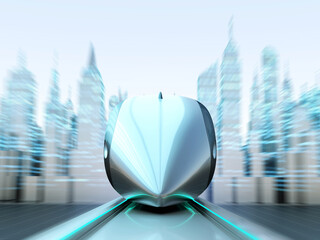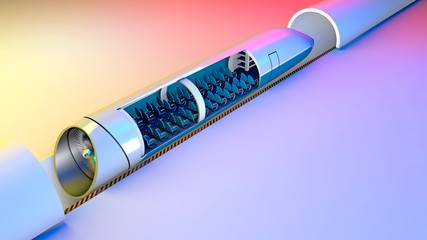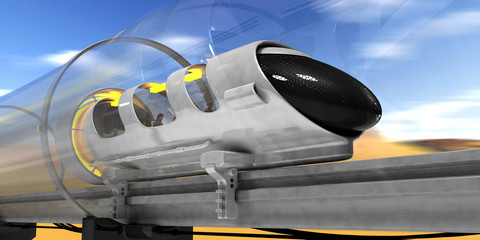Future Transportation Technologies
HYPER-LOOP

Transportation allows us to move very fast, everywhere. But, imagine, you just hop on a capsule or a train and you can go travel long distance in short period of time.The Hyperloop combines all of the advantages of all of our current modes of transport that we know today. It's on demand, it's direct,it's energy efficient, it's emission free. It would shrink distances between cities, between countries, between continents in a way that has never been done before.What people might not realize today,is that this new mode of transportation will have an impacting their daily lives.There hasn't been any revolution in the transportation system in over 100 years and it's happening as we speak.Here we are in the laboratory of EPF Loop.This lab is part of the School of Electrical Engineering.Everything that you see here is always moving because people are coming, making prototypes,testing.One of the most interesting props that comes from the 80s is this levitating plate.Basically here there are coils inside the structure and the magnetic field is created by these coils.And if we start basically the motor of this coil, you can see that it's levitating.We can use these systems in a bigger scale.And that's also where the Hyperloop enters in the equation.The Hyperloop is a new mode of transportation that would carry passengers or cargo.They would be loaded into the Hyperloop pod, which would then accelerate via electric propulsion in a low pressure vacuum tube.The pod is fully autonomous.It's also protected from weather hazards and is clean in the sense that it has no direct carbon emissions.It's kind of having an airplane without wings, similar as a flying train.As we speak today in the U.S.,there are projects that are being concretely developed and that aim to connect major cities.Hop on a pod can revolutionize their future of transportation in the same way that mobile phone revolutionized the way we connect.If we want to look at the impact that it would have on our economy today, we can take for example,cargo transportation.

There is a study that says that thee-commerce will be worth around four trillion U.S. dollars in the next two years and a Hyperloop enabled cargo transport would really make it possible to transport goods at the speed of flight and that the cost of trucking.It would be very easy for everybody to take it because it will be something like another train, just faster. Way faster! We get our inspiration from a project that started out in 1974 and then was undertook by a team of professors right here at EPFL.In fact, right here in this lab, that is called the project Swiss metro.They estimated that by the time that the regulatory push would be socially accepted around 2020,and well, here we are two years away from the post deadline and we see companies such as Virgin Hyperloop announcing that they would like to have fully functional, full-scale Hyperloops by mid 2020.But we're also facing the same types of congestions on the roads, airports ports. The Swiss metro is really anchored in our project's DNA and in this school's DNA. Having such a pioneering project that was developed right here on campus is a huge advantage for us in order to really develop further our project and accelerate the future of transportation known as the Hyperloop today.

There was not that global reception as now and, probably that's also the reason why it didn't have enough traction to get there.Back in 2013, Elon Musk published his white paper on Hyperloop Alpha. And there was this general wave of excitement around this promising new technology.Two years later, they decided to expand this research contest to universities.The idea is to make it possible for students and young engineers around the world to really contribute to the development of the open source knowledge around the Hyperloopand make it more challenging seeing as it's a competition.The Hyperloop competition is the objective of creating the fastest pod inside the tube that is located at SpaceX headquarters in Hawthorne, California. We go through different steps of validation along the entire process to make sure that the quality of the engineering that we are sending as reference to SpaceX is top notch, and that our prototype is safe and is worthy of entering the SpaceX vacuum tube. And so, slowly you start developing like these willingness to create something new. And then in January,we received the news that we were actually invited to go L.A. So everybody was super pump and we said, okay, let's go, let's do this. At the competition we finished third.Third in the world is a very good score. And so, now people are starting to hear about us and even better they're excited to hear about the project and even try to help if they can. Three, two, one! This is a science fair organized by EPFL.Safety is really the number one priority when it comes to designing the Hyperloop. Demonstrating that it's technologically feasible is one step but still you need to make sure that the people are ready for this kind of technology. At the beginning you're a fan of the project, then you became supporter of the project. At this point I feel like I'm kind of obsessed with the project. There are a lot of factors that you have to take into account that are not directly related to the technology itself that you're developing. There's a lot of work that comes from developing go hand-in-hand with the government and regulatory entities, a legal framework that would make it safe and scalable really to implement this technology. In the case of Swiss metro, the project was kind of too far ahead in its time and there wasn't really an actual demand for this way of transportation. There needs to be some kind of social acceptance. You need to feel comfortable walking into the Hyperloop, trusting this technology to get you from point A to Point B, kind of by the speed of light. The possibility of make the distance between two different places so short that you can just jump on the Hyperloop and then in 20 minutes you are across the country, it's amazing and it's a very inspiring opportunity. Imagine a world in the future that is smaller, greener and connects people in a way that we've never witnessed before.
ULTRA LIGHT ELECTRIC VEHICLE
At Automotive NEX Industry Fair 2010, Waseda Environmental Institute presented an ultra-light electric vehicle called the ULV. This is a one-person eco-car developed by Waseda University’s Nagata Laboratory, based on the concept of “more than a bike, less than a car”. This vehicle with the yellow body weighs 72.6 kg. It’s so light that it can be carried by two people. As a way of using the ULV, for example, it could be driven around town as an advertising medium, for environmental publicity campaigns by businesses. Or in areas where train stations are a long way apart, it could be used instead of a rental bicycle, to get from one station to another. The ULV can be charged in four hours. It has a 400 W motor and a top speed of 40 km/h, and it can travel continuously for 80 km. Recently supplied the ULV as a delivery vehicle to a business in Honjo, Saitama.
The business is an eel restaurant, so the front of the vehicle was customized to look like an eel’s head. This is really eye-catching on the road, and if the body is customized as well, we think the ULV could be used as an advertising medium.Waseda Environmental Institute’s ultimate goal is “to change the way people think about mobility” through the ULV. From now on, the Institute aims to raise awareness by exhibiting the ULV at environmental events, and make the ULV practical as a means of mobility in community transport systems.


Comments
Post a Comment
Please do not enter any spam link in the comment box.